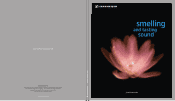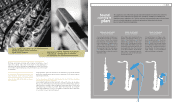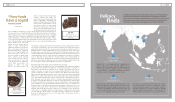Sennheiser 2009 Annual Report Download - page 5
Download and view the complete annual report
Please find page 5 of the 2009 Sennheiser annual report below. You can navigate through the pages in the report by either clicking on the pages listed below, or by using the keyword search tool below to find specific information within the annual report.
8COMPOSITION
A tone, a chord, a sound. Three words, one sensuous realm in which we are immediately
transported to the land of sound located in the world of music. But even as we explore
this new territory, we come across similar terminology in the land of fragrances.
Accords, harmonies and consonances permeate the perfumers’ language. Knowing
how much our speech mirrors our thoughts, it is fascinating to discover how very
similar the vocabulary used to describe a piece of music and a fragrance actually is.
Both are built up on a “note.” For the one, it is a musical note. For the other, a perfume
note. One requires various musical elements to compose a coherent opus, a melodic
sequence of recurring musical notes; the other requires a variety of substances to
compose a fragrant nosegay, an aromatic sequence of recurring perfume notes. It’s no
wonder composers have tried to come up with their own
musical interpretation of fragrance – albeit rarely. A hundred
years ago, French composer Claude Debussy successfully
translated music into fragrance in his orchestral masterpiece
Les parfums de la nuit: the fragrance of the night. Its title is
as mysterious as it is evocative. Whenever I listen to it, I am
transported to a warm summer night on the Iberian Peninsula,
where a bouquet of flowers and Mediterranean trees exhale
their fragrance in a gentle wave of perfume carried on a light
breeze. Debussy’s unique compositional style lends itself to
creating such musical illusions. His colorful harmonies create
richly sophisticated and imaginative melodies that release him
from the constraints of traditional harmonies. Debussy’s music
lingers. It is indefinable.
Fragrance has neither physical nor material counterpart
Although there are linguistic similarities, perfume and music
are built on two very different sensory modalities and, without
a common frame of reference, it is not easy to compare
them. Music’s unique elements of notes, scales, chords and
rhythms, however, can be described and measured according to
such physical parameters as pitch, volume and tempo. What is
not measurable is the connection between fragrance
and music, between a musical note and a perfume
note, between a musical chord and a perfume accord.
Fragrance has no physical or material counterpart.
Unlike sound recording, it is not possible to record the
smell of perfume and then use modern technology to
encode its substance and spirit into bits and bytes.
A good recording is an emotional experience
If I wanted to enjoy a perfume in a different location
or at some other time, I would have to secure the
perfume composition and its ingredients in its original
formulation. It’s different with music. I get the same
feeling of sound and emotion from listening to a
faithfully reproduced musical performance – meaning
a good recording taken up by perfectly matched
instrumental, vocal and studio microphones. Sub-
merging oneself in fragrance or music isn’t just a
matter of fragrant substances and musical elements.
Other factors such as one’s mood, expectations, social
context or room conditions can play an important part
in their modality. But do music and fragrance ever play
in counterpoint? Yes. Their common
attribute is their ability to create an
atmosphere. A mood. A lingering
impression in the air that is perceived
by all the senses: hearing, smell,
sight, touch and taste.
Quiet tones – delicate fragrances
One way to understand how music
and fragrance intertwine is to
describe their notes. In music, high
notes are associated with brightness and
a sense of spatial height; low tones with
darkness and heaviness. In the perfumery,
high notes describe fresh, light notes; low
notes, deep and rather intense oriental
fragrances. A quick musical tempo signifies
the smell of cologne as it quickly fades away.
A leisurely tempo conjures up the sense of
heavier, muskier notes. Loud sounds reflect a
fragrance’s intensity; soft sounds, delicate
or light fragrances. However, there has likely
never been such a beautiful combination of
fragrances as those interpreted by Debussy
in his Les parfums de la nuit.
Though musicians and perfumers may have a different raison d’être,
they speak a common language. One that creates a mood and fills the air with magic.
An essay by Heiner Gembris, Professor of Empirical Music Education and Music Psychology, Paderborn, Germany


















